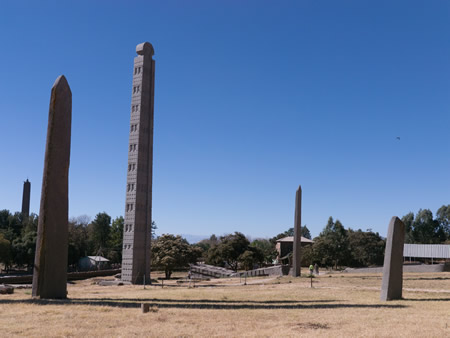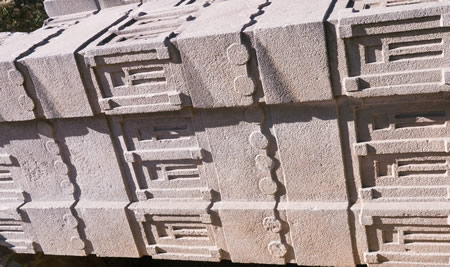Axum Obelisks
Axum or Aksum is a city in the northern part of Ethiopia. The town has a population of 56,500 residents (2010), and is governed as an urban wäräda.
The original capital of the Kingdom of Aksum, it is one of the oldest continuously inhabited places in Africa. Axum was a naval and trading power that ruled the region from about 400 BCE into the 10th century. In 1980 UNESCO added Aksum's archaeological sites to its list of World Heritage Sites due to their historic value.
Located in the Mehakelegnaw Zone of the Tigray Region near the base of the Adwa mountains, Axum has an elevation of 2,131 metres (6,991 ft). Axum is surrounded by La'ilay Maychew wäräda.
History
Axum was the center of the marine trading power known as the Aksumite Kingdom, which predated the earliest mentions in Roman era writings. Around 356 CE, its ruler was converted to Christianity by Frumentius. Later, under the reign of Kaleb, Axum was a quasi-ally of Byzantium against the Sasanian Persian Empire which had adopted Zoroastrianism. The historical record is unclear, with ancient church records the primary contemporary sources.
 It is believed it began a long slow decline after the 7th century due partly to the Persians and finally the Arabs contesting old Red sea trade routes. Eventually Aksum was cut off from its principal markets in Alexandria, Byzantium and Southern Europe and its trade share was captured by Arab traders of the era. The Kingdom of Aksum was finally destroyed by Gudit, and eventually some of the people of Aksum were forced south and their civilization declined. As the kingdom's power declined so did the influence of the city, which is believed to have lost population in the decline, similar to Rome and other cities thrust away from the flow of world events. The last known (nominal) king to reign was crowned in about the 10th century, but the kingdom's influence and power ended long before that.
It is believed it began a long slow decline after the 7th century due partly to the Persians and finally the Arabs contesting old Red sea trade routes. Eventually Aksum was cut off from its principal markets in Alexandria, Byzantium and Southern Europe and its trade share was captured by Arab traders of the era. The Kingdom of Aksum was finally destroyed by Gudit, and eventually some of the people of Aksum were forced south and their civilization declined. As the kingdom's power declined so did the influence of the city, which is believed to have lost population in the decline, similar to Rome and other cities thrust away from the flow of world events. The last known (nominal) king to reign was crowned in about the 10th century, but the kingdom's influence and power ended long before that.
Its decline in population and trade then contributed to the shift of the power center of the Ethiopian Empire south to the Agaw region as it moved further inland. The city of Axum was the administrative seat of an empire spanning 1 million square miles. Eventually, the alternative name (Ethiopia) was adopted by the central region, and subsequently, the present modern state.
Monuments
 The major Aksumite monuments in the town are stelae. These obelisks are around 1,700 years old and have become a symbol of the Ethiopian people's identity. The largest number are in the Northern Stelae Park, ranging up to the 33-metre-long (3.84 metres wide, 2.35 metres deep, weighing 520 tonnes) Great Stele, believed to have fallen and broken during construction. The Obelisk of Axum (24.6 metres high, 2.32 metres wide, 1.36 metres deep, weighing 170 tonnes) was removed by the Italian army in 1937, and returned to Ethiopia in 2005 and reinstalled July 31, 2008. This stele was already broken into pieces before being shipped. The next tallest is the 24-metre (20.6 metres high above the front baseplate, 2.65 metres wide, 1.18 metres deep, weighing 160 tonnes) King Ezana's Stele. Three more stelae measure 18.2 metres high, 1.56 metres wide, 0.76 metres deep, weighing 56 tonnes; 15.8 metres high, 2.35 metres wide, 1 metres deep, weighing 75 tonnes; 15.3 metres high, 1.47 metres wide, 0.78 metres deep, weighing 43 tonnes. The stelae are believed to mark graves and would have had cast metal discs affixed to their sides, which are also carved with architectural designs. The Gudit Stelae to the west of town, unlike the northern area, are interspersed with mostly 4th century tombs.
The major Aksumite monuments in the town are stelae. These obelisks are around 1,700 years old and have become a symbol of the Ethiopian people's identity. The largest number are in the Northern Stelae Park, ranging up to the 33-metre-long (3.84 metres wide, 2.35 metres deep, weighing 520 tonnes) Great Stele, believed to have fallen and broken during construction. The Obelisk of Axum (24.6 metres high, 2.32 metres wide, 1.36 metres deep, weighing 170 tonnes) was removed by the Italian army in 1937, and returned to Ethiopia in 2005 and reinstalled July 31, 2008. This stele was already broken into pieces before being shipped. The next tallest is the 24-metre (20.6 metres high above the front baseplate, 2.65 metres wide, 1.18 metres deep, weighing 160 tonnes) King Ezana's Stele. Three more stelae measure 18.2 metres high, 1.56 metres wide, 0.76 metres deep, weighing 56 tonnes; 15.8 metres high, 2.35 metres wide, 1 metres deep, weighing 75 tonnes; 15.3 metres high, 1.47 metres wide, 0.78 metres deep, weighing 43 tonnes. The stelae are believed to mark graves and would have had cast metal discs affixed to their sides, which are also carved with architectural designs. The Gudit Stelae to the west of town, unlike the northern area, are interspersed with mostly 4th century tombs.
Other attractions in Axum include archaeological and ethnographic museums, the Ezana Stone written in Sabaean, Ge'ez and Ancient Greek in a similar manner to the Rosetta Stone, King Bazen's Tomb (a megalith considered to be one of the earliest structures), the so-called Queen of Sheba's Bath (actually a reservoir), the 4th-century Ta'akha Maryam and 6th-century Dungur palaces, the monasteries of Abba Pentalewon and Abba Liqanos and the Lioness of Gobedra rock art.
Local legend claims the Queen of Sheba lived in the town.
Gallery
Megalithic Builders is an index of ancient sites from around the world that contain stone megaliths or interlocking stones. Genus Dental Sacramento

